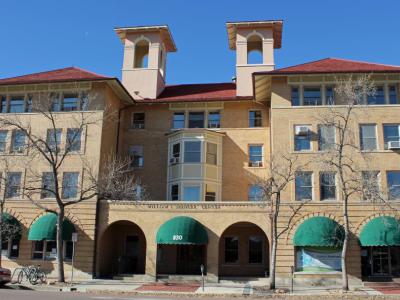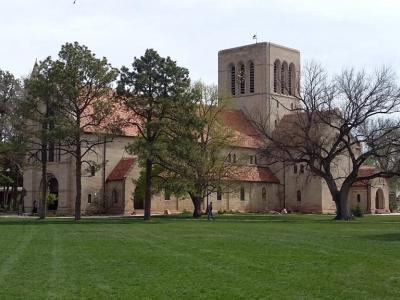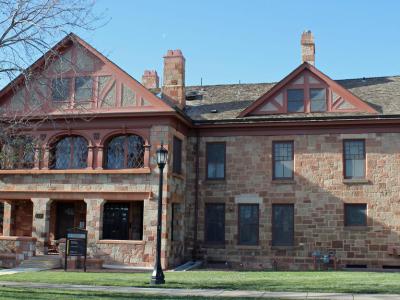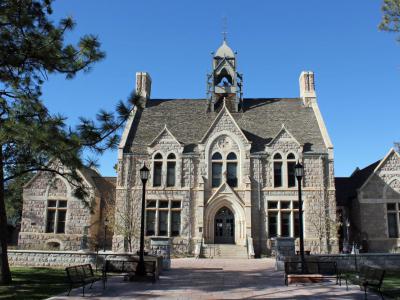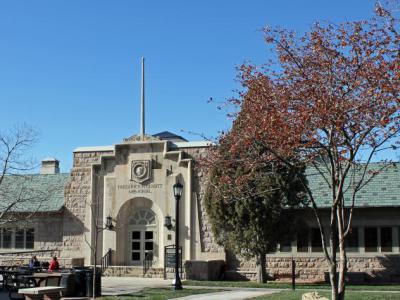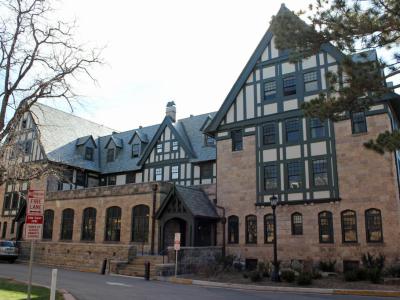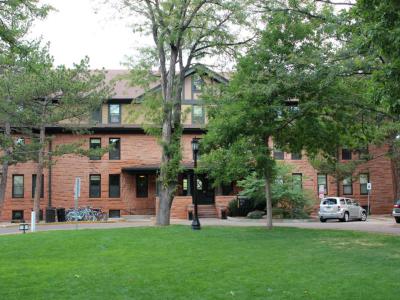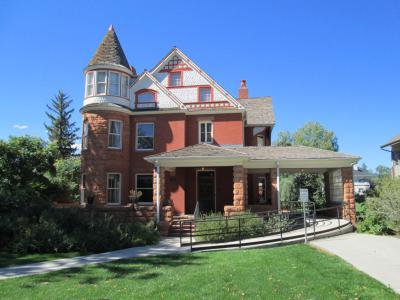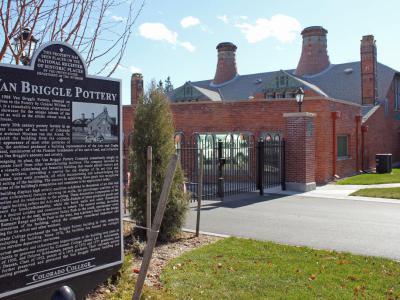Colorado College Historical Buildings Walking Tour (Self Guided), Colorado Springs
Founded in 1874, Colorado College stands out as one of the earliest institutions in Colorado to confer academic degrees. It was established through the efforts of General William Palmer, the founder of Colorado Springs, and Henry McAllister, a director of the Colorado Springs Company, both of whom contributed land along Cascade Avenue for the campus, setting the foundation for the college's development.
The campus is noted for its architectural significance, featuring some of the most important historic buildings in the city. These include examples of Romanesque and Classical Revival styles, as well as English-influenced designs prevalent during the "Little London" era of Colorado Springs. The strategic location of Colorado College has also played a crucial role in the development of the north-central area of the city. The institution's prestige and the architectural excellence of its buildings are mirrored in the high quality of the nearby residential neighborhood.
Among the local architectural treasures, the William L Spencer Center, formerly known as the Plaza Hotel, stands out with its historic façade, now serving as a vibrant administrative hub.
Another gem is the Shove Memorial Chapel, a spiritual sanctuary on campus, renowned for its beautiful stained glass windows and rich acoustics, making it a favorite for wedding ceremonies. Nearby, the Lennox House and Edgeplain, both residential structures, showcase distinct architectural styles from the eras they were built, offering a glimpse into the domestic aesthetics of their times.
Palmer Hall, an academic building named after the city’s founder, General William Jackson Palmer, completed in 1904, symbolizes the achievements of President William F Slocum's era, while Cutler Hall, the oldest building on campus, represents the college's foundation, housing important administrative offices.
Frederick H Cossitt Memorial Hall, originally a gymnasium, now functions as a dynamic space for dance and theatre, reflecting the adaptive reuse prevalent across the campus. Lastly, the Van Briggle Pottery Company building, an artistic landmark, showcases the unique Van Briggle pottery style that gained national fame.
These and other historic buildings at Colorado College are not just structures, but the pillars of heritage and education. If you're interested in history and architecture, or simply looking for a beautiful and intellectually stimulating environment, a visit to the college's campus will offer you an enriching experience.
The campus is noted for its architectural significance, featuring some of the most important historic buildings in the city. These include examples of Romanesque and Classical Revival styles, as well as English-influenced designs prevalent during the "Little London" era of Colorado Springs. The strategic location of Colorado College has also played a crucial role in the development of the north-central area of the city. The institution's prestige and the architectural excellence of its buildings are mirrored in the high quality of the nearby residential neighborhood.
Among the local architectural treasures, the William L Spencer Center, formerly known as the Plaza Hotel, stands out with its historic façade, now serving as a vibrant administrative hub.
Another gem is the Shove Memorial Chapel, a spiritual sanctuary on campus, renowned for its beautiful stained glass windows and rich acoustics, making it a favorite for wedding ceremonies. Nearby, the Lennox House and Edgeplain, both residential structures, showcase distinct architectural styles from the eras they were built, offering a glimpse into the domestic aesthetics of their times.
Palmer Hall, an academic building named after the city’s founder, General William Jackson Palmer, completed in 1904, symbolizes the achievements of President William F Slocum's era, while Cutler Hall, the oldest building on campus, represents the college's foundation, housing important administrative offices.
Frederick H Cossitt Memorial Hall, originally a gymnasium, now functions as a dynamic space for dance and theatre, reflecting the adaptive reuse prevalent across the campus. Lastly, the Van Briggle Pottery Company building, an artistic landmark, showcases the unique Van Briggle pottery style that gained national fame.
These and other historic buildings at Colorado College are not just structures, but the pillars of heritage and education. If you're interested in history and architecture, or simply looking for a beautiful and intellectually stimulating environment, a visit to the college's campus will offer you an enriching experience.
How it works: Download the app "GPSmyCity: Walks in 1K+ Cities" from Apple App Store or Google Play Store to your mobile phone or tablet. The app turns your mobile device into a personal tour guide and its built-in GPS navigation functions guide you from one tour stop to next. The app works offline, so no data plan is needed when traveling abroad.
Colorado College Historical Buildings Walking Tour Map
Guide Name: Colorado College Historical Buildings Walking Tour
Guide Location: USA » Colorado Springs (See other walking tours in Colorado Springs)
Guide Type: Self-guided Walking Tour (Sightseeing)
# of Attractions: 14
Tour Duration: 2 Hour(s)
Travel Distance: 2.4 Km or 1.5 Miles
Author: irenes
Sight(s) Featured in This Guide:
Guide Location: USA » Colorado Springs (See other walking tours in Colorado Springs)
Guide Type: Self-guided Walking Tour (Sightseeing)
# of Attractions: 14
Tour Duration: 2 Hour(s)
Travel Distance: 2.4 Km or 1.5 Miles
Author: irenes
Sight(s) Featured in This Guide:
- William L Spencer Center (Plaza Hotel)
- Shove Memorial Chapel
- Lennox House
- Edgeplain
- Palmer Hall
- Cutler Hall
- Frederick H. Cossitt Memorial Hall
- Bemis Hall
- McGregor Hall
- Ticknor Hall
- Montgomery Hall
- Lindley-Johnson-Vanderhoof House
- Ida M. Rice House
- Van Briggle Pottery Company
1) William L Spencer Center (Plaza Hotel)
The William L Spencer Center, historically known as the Plaza Hotel, stands as a prominent landmark in Colorado Springs, boasting a captivating blend of Renaissance and Mission Revival architectural styles. Constructed in 1901 by W. W. & G. F. Atkinson, this four-story hotel features a striking façade crafted from cream-colored pressed brick. Its architectural significance earned it a coveted spot on the National Register of Historic Places in 1983, recognizing its contribution to the rich cultural tapestry of the region.
Originally serving as the Plaza Hotel, this iconic building witnessed various transitions over the years. While it continued to operate as a hotel until the late 1960s, a portion of the premises briefly served as the corporate headquarters of the Nestlé Company in the early 1950s. Additionally, during its heyday, a drugstore located on the first story of the hotel's northeast corner catered to students, offering prescriptions, toiletries, and a popular soda fountain.
In 1991, Colorado College seized the opportunity to acquire the building, renaming it the William L Spencer Center in honor of William I. Spencer, a distinguished alumnus. Spencer, a Colorado College graduate and prominent figure in the banking sector, played a pivotal role in the institution's development. As a member of the Colorado College Board of Trustees and later its chairman, Spencer's leadership and commitment left an indelible mark on the college's legacy. The renaming ceremony, held on October 5, 1991, marked a fitting tribute to Spencer's enduring contributions to Colorado College and the broader community.
Originally serving as the Plaza Hotel, this iconic building witnessed various transitions over the years. While it continued to operate as a hotel until the late 1960s, a portion of the premises briefly served as the corporate headquarters of the Nestlé Company in the early 1950s. Additionally, during its heyday, a drugstore located on the first story of the hotel's northeast corner catered to students, offering prescriptions, toiletries, and a popular soda fountain.
In 1991, Colorado College seized the opportunity to acquire the building, renaming it the William L Spencer Center in honor of William I. Spencer, a distinguished alumnus. Spencer, a Colorado College graduate and prominent figure in the banking sector, played a pivotal role in the institution's development. As a member of the Colorado College Board of Trustees and later its chairman, Spencer's leadership and commitment left an indelible mark on the college's legacy. The renaming ceremony, held on October 5, 1991, marked a fitting tribute to Spencer's enduring contributions to Colorado College and the broader community.
2) Shove Memorial Chapel
Constructed between 1930 and 1931, Shove Memorial Chapel is celebrated as one of the foremost examples of Norman Romanesque architecture in the United States. Inspired by the grandeur of historic churches in England and Normandy, its design embodies traditional Romanesque elements, including imposing masonry walls, semi-circular arches, wall arcades, and a commanding tower.
Architect John Gray's vision for Shove Memorial Chapel marked a pivotal moment in his career, representing his inaugural major project after establishing his own practice. Renowned as his magnum opus, Gray's comprehensive design ranged from the minutiae of door hinges to the intricacies of memorial tablet prints. Despite the economic challenges of the Great Depression, both donor and architect shared a unified commitment to excellence, sparing no effort to blend the finest materials, artistry, and craftsmanship.
The meticulous execution of Gray's design enlisted artisans and craftsmen from across the nation. Master stone carver John Bruce meticulously crafted ornamental stonework, while Denver sculptor Robert Garrison lent his talent to the creation of exterior carvings, including the striking gargoyles and carved heads. Inside, the expertise of Robert E. Wade graced the ceilings with his masterful paintings, enhancing the chapel's interior ambiance. Joseph Reynolds Jr., of the esteemed Boston firm Reynolds, Francis, and Rohnstock, contributed his expertise to the design of the magnificent stained glass windows.
One notable feature of Shove Memorial Chapel is its east wall, adorned with ancient stones sourced from significant buildings in England that held personal importance to the Shove family. This incorporation of historic elements adds a layer of depth and reverence to the chapel's already profound significance.
Architect John Gray's vision for Shove Memorial Chapel marked a pivotal moment in his career, representing his inaugural major project after establishing his own practice. Renowned as his magnum opus, Gray's comprehensive design ranged from the minutiae of door hinges to the intricacies of memorial tablet prints. Despite the economic challenges of the Great Depression, both donor and architect shared a unified commitment to excellence, sparing no effort to blend the finest materials, artistry, and craftsmanship.
The meticulous execution of Gray's design enlisted artisans and craftsmen from across the nation. Master stone carver John Bruce meticulously crafted ornamental stonework, while Denver sculptor Robert Garrison lent his talent to the creation of exterior carvings, including the striking gargoyles and carved heads. Inside, the expertise of Robert E. Wade graced the ceilings with his masterful paintings, enhancing the chapel's interior ambiance. Joseph Reynolds Jr., of the esteemed Boston firm Reynolds, Francis, and Rohnstock, contributed his expertise to the design of the magnificent stained glass windows.
One notable feature of Shove Memorial Chapel is its east wall, adorned with ancient stones sourced from significant buildings in England that held personal importance to the Shove family. This incorporation of historic elements adds a layer of depth and reverence to the chapel's already profound significance.
3) Lennox House
The Lennox House has a rich history dating back to its construction in 1900. Originally built for a prominent businessman, the house later became an integral part of the Colorado College campus in 1936. Its association with the development of north Colorado Springs underscores its significance in the region's history. Moreover, the Lennox House played a pivotal role in the college's narrative, serving as the Student Union from 1937 to 1959, thereby becoming a central hub of campus life.
Architecturally, the Lennox House is a striking example of the Mission Revival style, characterized by its distinctive features and attention to detail. Designed by renowned Denver architect Frederick J. Sterner, the building showcases his mastery in blending traditional elements with modern aesthetics. Its architectural significance is further highlighted by its inclusion in the Historic Resources of Colorado College Multiple Property Submission, recognizing its contribution to the cultural and architectural landscape of the area.
Today, the Lennox House stands as a testament to the enduring legacy of both its original owner and Colorado College. Its well-preserved Mission Revival architecture serves as a visual reminder of the region's rich heritage and the college's historic evolution. As a designated historic property, the Lennox House continues to contribute to the cultural fabric of Colorado Springs, offering visitors a glimpse into the past while remaining an integral part of the present-day campus environment.
Architecturally, the Lennox House is a striking example of the Mission Revival style, characterized by its distinctive features and attention to detail. Designed by renowned Denver architect Frederick J. Sterner, the building showcases his mastery in blending traditional elements with modern aesthetics. Its architectural significance is further highlighted by its inclusion in the Historic Resources of Colorado College Multiple Property Submission, recognizing its contribution to the cultural and architectural landscape of the area.
Today, the Lennox House stands as a testament to the enduring legacy of both its original owner and Colorado College. Its well-preserved Mission Revival architecture serves as a visual reminder of the region's rich heritage and the college's historic evolution. As a designated historic property, the Lennox House continues to contribute to the cultural fabric of Colorado Springs, offering visitors a glimpse into the past while remaining an integral part of the present-day campus environment.
4) Edgeplain
Edgeplain, also known as the Arthur House, stands as a cherished landmark on the Colorado College campus, ensconced in the annals of history and architectural splendor. Listed on the National Register of Historic Places, this venerable building has witnessed the ebb and flow of time, embodying the rich tapestry of the region's heritage.
Constructed in 1881 by Lyman Bass, a prominent attorney with ties to luminaries such as Grover Cleveland and William Jackson Palmer, Edgeplain was initially envisioned as a grand Tudor Revival home nestled amidst the pristine expanse of undeveloped prairie. Renowned architect A.C. Williard was tasked with bringing Bass's vision to life, resulting in a masterpiece of architectural finesse and opulence. The $115,000 estate boasted distinctive stonework, adorned with a myriad of colors and finishes, including pecked and vermiculated masonry dressings, showcasing the unparalleled craftsmanship of the era.
Over the years, Edgeplain became synonymous with refined elegance and sophisticated gatherings, playing host to luminaries from the realms of politics, arts, and culture. Following Bass's passing, the residence changed hands several times before finding itself in the possession of Chester Alan Arthur II, son of President Chester A. Arthur. Under the stewardship of the Arthur family, the estate underwent extensive expansions and renovations, further enhancing its allure as a premier social venue in the region.
In 1922, Colorado College acquired Edgeplain, repurposing it as a men's dormitory and later transitioning it into a coeducational residence hall. Today, this historic edifice continues to serve as a cherished home for students, offering a unique blend of living, kitchen, and recreational spaces that foster a vibrant sense of community and camaraderie.
Constructed in 1881 by Lyman Bass, a prominent attorney with ties to luminaries such as Grover Cleveland and William Jackson Palmer, Edgeplain was initially envisioned as a grand Tudor Revival home nestled amidst the pristine expanse of undeveloped prairie. Renowned architect A.C. Williard was tasked with bringing Bass's vision to life, resulting in a masterpiece of architectural finesse and opulence. The $115,000 estate boasted distinctive stonework, adorned with a myriad of colors and finishes, including pecked and vermiculated masonry dressings, showcasing the unparalleled craftsmanship of the era.
Over the years, Edgeplain became synonymous with refined elegance and sophisticated gatherings, playing host to luminaries from the realms of politics, arts, and culture. Following Bass's passing, the residence changed hands several times before finding itself in the possession of Chester Alan Arthur II, son of President Chester A. Arthur. Under the stewardship of the Arthur family, the estate underwent extensive expansions and renovations, further enhancing its allure as a premier social venue in the region.
In 1922, Colorado College acquired Edgeplain, repurposing it as a men's dormitory and later transitioning it into a coeducational residence hall. Today, this historic edifice continues to serve as a cherished home for students, offering a unique blend of living, kitchen, and recreational spaces that foster a vibrant sense of community and camaraderie.
5) Palmer Hall
Palmer Hall stands as a revered emblem of Colorado College's rich history and architectural heritage, epitomizing the culmination of President William F. Slocum's ambitious construction endeavors during his tenure from 1888 to 1917. Completed in 1904, this majestic edifice, designed in the Romanesque Revival style, was a collaborative vision brought to life by the esteemed Boston architectural firm of Andrews, Jacques, and Rantoul. Crafted from exquisite peachblow sandstone sourced from a quarry in Pitkin County's Frying Pan River, Palmer Hall remains a testament to the college's early architectural prowess.
The dedication ceremony on 23 February 1904 marked a momentous occasion in the annals of Colorado College's history, drawing dignitaries, representatives from over 50 colleges and universities, Governor James Peabody, and General William Jackson Palmer himself. Named in honor of the illustrious General Palmer, founder of Colorado Springs and a pivotal figure in the region's development, the building symbolizes the enduring legacy of a visionary leader and philanthropist. Inside Palmer Hall, a captivating oil portrait by Hubert von Herkomer and a bas relief plaque crafted by Evelyn Beatrice Longman pay homage to General Palmer, underscoring his profound impact on the college and the wider community.
Beyond its architectural splendor, Palmer Hall holds a cherished place in the hearts of students, faculty, and staff, embodying a tradition of academic excellence and camaraderie. The building's interior, adorned with notable artworks and memorabilia, serves as a living testament to the enduring spirit of the college and its esteemed benefactors. One beloved tradition sees students rubbing the nose of a dog depicted in a bas relief plaque for luck before exams, a charming ritual that underscores the enduring bond between past and present generations of Colorado College scholars.
The dedication ceremony on 23 February 1904 marked a momentous occasion in the annals of Colorado College's history, drawing dignitaries, representatives from over 50 colleges and universities, Governor James Peabody, and General William Jackson Palmer himself. Named in honor of the illustrious General Palmer, founder of Colorado Springs and a pivotal figure in the region's development, the building symbolizes the enduring legacy of a visionary leader and philanthropist. Inside Palmer Hall, a captivating oil portrait by Hubert von Herkomer and a bas relief plaque crafted by Evelyn Beatrice Longman pay homage to General Palmer, underscoring his profound impact on the college and the wider community.
Beyond its architectural splendor, Palmer Hall holds a cherished place in the hearts of students, faculty, and staff, embodying a tradition of academic excellence and camaraderie. The building's interior, adorned with notable artworks and memorabilia, serves as a living testament to the enduring spirit of the college and its esteemed benefactors. One beloved tradition sees students rubbing the nose of a dog depicted in a bas relief plaque for luck before exams, a charming ritual that underscores the enduring bond between past and present generations of Colorado College scholars.
6) Cutler Hall
Cutler Hall, a distinguished landmark on the Colorado College campus, stands as a testament to the institution's rich history and enduring legacy. This magnificent Gothic library building, listed on the National Register of Historic Places, holds a significant place in the annals of the college's development.
Constructed between 1877 and 1880, Cutler Hall holds the distinction of being the inaugural building on the Colorado College campus. Originally known simply as "the College," it served as the nucleus of the burgeoning institution, housing offices, classrooms, a library, auditorium, and more. Today, it continues to serve the college community, housing the financial aid and admissions departments.
In 1889, in recognition of William Jackson Palmer's unwavering support for the college, the building was renamed Palmer Hall. Palmer's generous contributions funded the construction of a new science building, which was aptly named Palmer Hall. The original college building, in turn, was dedicated to philanthropist Henry Cutler, who had been a significant benefactor to the college.
Designed in the High Victorian Gothic style by the esteemed Boston architectural firm of Peabody and Stearns, Cutler Hall boasts a grandeur and elegance befitting its historical significance. Flanking wings were added to the building in 1881-1882, further enhancing its architectural splendor. The bell atop the building, once used to summon students to classes and celebrate athletic victories, holds its own place in the building's lore, despite being irreparably damaged. As a symbol of resilience, the Navy loaned a bell from the World War II carrier, the U.S.S. Geneva, to replace it, ensuring that Cutler Hall's legacy endures for generations to come.
Constructed between 1877 and 1880, Cutler Hall holds the distinction of being the inaugural building on the Colorado College campus. Originally known simply as "the College," it served as the nucleus of the burgeoning institution, housing offices, classrooms, a library, auditorium, and more. Today, it continues to serve the college community, housing the financial aid and admissions departments.
In 1889, in recognition of William Jackson Palmer's unwavering support for the college, the building was renamed Palmer Hall. Palmer's generous contributions funded the construction of a new science building, which was aptly named Palmer Hall. The original college building, in turn, was dedicated to philanthropist Henry Cutler, who had been a significant benefactor to the college.
Designed in the High Victorian Gothic style by the esteemed Boston architectural firm of Peabody and Stearns, Cutler Hall boasts a grandeur and elegance befitting its historical significance. Flanking wings were added to the building in 1881-1882, further enhancing its architectural splendor. The bell atop the building, once used to summon students to classes and celebrate athletic victories, holds its own place in the building's lore, despite being irreparably damaged. As a symbol of resilience, the Navy loaned a bell from the World War II carrier, the U.S.S. Geneva, to replace it, ensuring that Cutler Hall's legacy endures for generations to come.
7) Frederick H. Cossitt Memorial Hall
Constructed in 1914, Frederick H. Cossitt Memorial Hall was designed by Maurice B. Biscoe and holds a prominent place on the National Register of Historic Places since 1997. The establishment of the Frederick H. Cossitt Memorial Hall addressed a longstanding need for facilities catering to the athletic and social pursuits of male students at the college.
The architectural design of Cossitt Hall is a captivating blend of Neoclassical and Modernistic elements, characterized by its eclectic style and innovative use of materials. Combining Castle Rock rhyolite, a signature feature of several historic college buildings, with concrete components, the building seamlessly integrates traditional and contemporary design principles. Upon its dedication in June 1914, Cossitt Hall boasted state-of-the-art amenities, including a basketball court, training rooms, locker facilities, and shower rooms, fostering a vibrant culture of athleticism and competition on campus.
Beyond its role as an athletic hub, Cossitt Hall served as a vibrant social center for male students, featuring a 200-person capacity dining room, a kitchen, and a common room for informal gatherings and reading. The spacious venue also accommodated student meetings and provided a platform for fostering camaraderie and community spirit. The building's significance was further enhanced in 1948 when artist Eric Bransby adorned the entrance rotunda with a striking mural, adding a touch of artistic splendor to its distinguished interior.
Today, Cossitt Hall continues to play a vital role in the academic and cultural life of Colorado College, housing the departments of Drama and Dance, as well as Classics and Comparative Literature. Its designation as a National Historic Landmark in 1997 underscores its enduring legacy and architectural significance, ensuring its preservation for future generations to cherish and appreciate.
The architectural design of Cossitt Hall is a captivating blend of Neoclassical and Modernistic elements, characterized by its eclectic style and innovative use of materials. Combining Castle Rock rhyolite, a signature feature of several historic college buildings, with concrete components, the building seamlessly integrates traditional and contemporary design principles. Upon its dedication in June 1914, Cossitt Hall boasted state-of-the-art amenities, including a basketball court, training rooms, locker facilities, and shower rooms, fostering a vibrant culture of athleticism and competition on campus.
Beyond its role as an athletic hub, Cossitt Hall served as a vibrant social center for male students, featuring a 200-person capacity dining room, a kitchen, and a common room for informal gatherings and reading. The spacious venue also accommodated student meetings and provided a platform for fostering camaraderie and community spirit. The building's significance was further enhanced in 1948 when artist Eric Bransby adorned the entrance rotunda with a striking mural, adding a touch of artistic splendor to its distinguished interior.
Today, Cossitt Hall continues to play a vital role in the academic and cultural life of Colorado College, housing the departments of Drama and Dance, as well as Classics and Comparative Literature. Its designation as a National Historic Landmark in 1997 underscores its enduring legacy and architectural significance, ensuring its preservation for future generations to cherish and appreciate.
8) Bemis Hall
Bemis Hall stands as a cherished edifice on the Colorado College campus, imbued with a rich history and architectural grandeur. Constructed in 1908, this distinguished Tudor Revival-style building originally served as a women's dormitory and dining hall, playing a pivotal role in shaping campus social life for female students during the early 20th century.
The architectural design of Bemis Hall, crafted by renowned architect Maurice B. Biscoe, reflects the prevailing philosophies of women's dormitories of its time. It exudes an aura of elegance and sophistication, characterized by its Tudor Revival-style facade and intricate detailing. The building's medieval-style dining hall, with its vaulted ceiling and dark paneled walls, served as a focal point for communal gatherings and shared meals, fostering a sense of camaraderie among residents.
The construction of Bemis Hall was made possible through generous contributions from notable figures such as General William Jackson Palmer, the esteemed founder of Colorado Springs and Colorado College, and Judson M. Bemis, a prominent manufacturer who relocated to Colorado Springs in the late 19th century. With funding secured, Biscoe's vision for the building came to life, accommodating 90 female residents and offering modern amenities along with timeless architectural charm.
Notably, the strategic placement of public spaces within the building ensured that most student rooms enjoyed ample natural light and picturesque views of the surrounding landscape, including the majestic peaks of Pikes Peak and the Rampart Range.
The architectural design of Bemis Hall, crafted by renowned architect Maurice B. Biscoe, reflects the prevailing philosophies of women's dormitories of its time. It exudes an aura of elegance and sophistication, characterized by its Tudor Revival-style facade and intricate detailing. The building's medieval-style dining hall, with its vaulted ceiling and dark paneled walls, served as a focal point for communal gatherings and shared meals, fostering a sense of camaraderie among residents.
The construction of Bemis Hall was made possible through generous contributions from notable figures such as General William Jackson Palmer, the esteemed founder of Colorado Springs and Colorado College, and Judson M. Bemis, a prominent manufacturer who relocated to Colorado Springs in the late 19th century. With funding secured, Biscoe's vision for the building came to life, accommodating 90 female residents and offering modern amenities along with timeless architectural charm.
Notably, the strategic placement of public spaces within the building ensured that most student rooms enjoyed ample natural light and picturesque views of the surrounding landscape, including the majestic peaks of Pikes Peak and the Rampart Range.
9) McGregor Hall
Constructed in 1903, McGregor Hall stands as a testament to the evolving landscape of education and the increasing prominence of women at Colorado College during the early 20th century. Designed by the esteemed architectural firm of Douglas and Hetherington, the building's distinctive Colonial Revival style is characterized by its robust Colorado Springs red sandstone construction, which lends it a timeless and stately appearance.
As the college's third dormitory for women, McGregor Hall played a pivotal role in accommodating the growing number of female students seeking higher education opportunities. Beyond its residential function, the building also housed the first women's athletic facility on campus, underscoring the college's commitment to promoting physical well-being and gender equality.
McGregor Hall exemplifies the architectural finesse and attention to detail characteristic of the early 20th century. Today, McGregor Hall stands as a cherished landmark within the Colorado College campus, embodying the rich heritage and enduring legacy of women's education in Colorado Springs.
As the college's third dormitory for women, McGregor Hall played a pivotal role in accommodating the growing number of female students seeking higher education opportunities. Beyond its residential function, the building also housed the first women's athletic facility on campus, underscoring the college's commitment to promoting physical well-being and gender equality.
McGregor Hall exemplifies the architectural finesse and attention to detail characteristic of the early 20th century. Today, McGregor Hall stands as a cherished landmark within the Colorado College campus, embodying the rich heritage and enduring legacy of women's education in Colorado Springs.
10) Ticknor Hall
Ticknor Hall stands as a testament to late 19th-century architectural excellence. Erected between 1897 and 1898, this venerable building was designed by the esteemed architectural firm of Douglas and Hetherington. Serving as the second women's dormitory on the campus of its inception, Ticknor Hall continues to fulfill this vital role, providing a nurturing and conducive living environment for students.
One of the hallmarks of Ticknor Hall is its striking construction, characterized by the prominent use of Colorado red and green dolostone. This choice of material not only lends the building a distinctive aesthetic appeal but also showcases the region's natural beauty and geological heritage. As a prime example of Late Victorian residential design adapted to collegiate architecture, Ticknor Hall embodies the architectural trends and sensibilities of its era, reflecting a harmonious blend of functionality and elegance.
Beyond its architectural significance, Ticknor Hall holds cultural and historical importance as a representation of the prevailing philosophies of collegiate housing for women during the late 19th century. With its home-like appearance and welcoming ambiance, the hall embodies the ethos of providing a supportive and nurturing environment conducive to academic and personal growth.
One of the hallmarks of Ticknor Hall is its striking construction, characterized by the prominent use of Colorado red and green dolostone. This choice of material not only lends the building a distinctive aesthetic appeal but also showcases the region's natural beauty and geological heritage. As a prime example of Late Victorian residential design adapted to collegiate architecture, Ticknor Hall embodies the architectural trends and sensibilities of its era, reflecting a harmonious blend of functionality and elegance.
Beyond its architectural significance, Ticknor Hall holds cultural and historical importance as a representation of the prevailing philosophies of collegiate housing for women during the late 19th century. With its home-like appearance and welcoming ambiance, the hall embodies the ethos of providing a supportive and nurturing environment conducive to academic and personal growth.
11) Montgomery Hall
Montgomery Hall stands as a testament to Colorado College's commitment to providing comprehensive residential facilities for its students. Constructed in 1891, it holds the distinction of being one of the original buildings on the Colorado College campus. Designed by renowned Colorado Springs architect Walter F. Douglas, the hall exudes a distinctive English charm, reflecting the architectural preferences of its time.
The genesis of Montgomery Hall can be traced back to the vision of Mary Slocum, wife of President William F. Slocum, who recognized the need for women's residential facilities to elevate Colorado College's stature beyond that of a local institution. Under her leadership, the college embarked on a mission to construct a residence for female students, culminating in the creation of Montgomery Hall. The hall's design, characterized by Castle Rock rhyolite walls, a welcoming porch, large windows, and dormers, aimed to evoke the ambiance of a stately residence, fostering a home-like atmosphere for its residents.
Named in honor of Mary Slocum's sister, Elizabeth Robinson Montgomery, Montgomery Hall holds a special place in the college's history. Elizabeth, who tragically passed away from consumption, played a pivotal role in championing the construction of the hall before her untimely demise. Over the years, Montgomery Hall has retained its architectural and historical significance, earning a coveted spot on the National Register of Historic Places in 1990, a testament to its enduring legacy as an integral part of Colorado College's heritage.
The genesis of Montgomery Hall can be traced back to the vision of Mary Slocum, wife of President William F. Slocum, who recognized the need for women's residential facilities to elevate Colorado College's stature beyond that of a local institution. Under her leadership, the college embarked on a mission to construct a residence for female students, culminating in the creation of Montgomery Hall. The hall's design, characterized by Castle Rock rhyolite walls, a welcoming porch, large windows, and dormers, aimed to evoke the ambiance of a stately residence, fostering a home-like atmosphere for its residents.
Named in honor of Mary Slocum's sister, Elizabeth Robinson Montgomery, Montgomery Hall holds a special place in the college's history. Elizabeth, who tragically passed away from consumption, played a pivotal role in championing the construction of the hall before her untimely demise. Over the years, Montgomery Hall has retained its architectural and historical significance, earning a coveted spot on the National Register of Historic Places in 1990, a testament to its enduring legacy as an integral part of Colorado College's heritage.
12) Lindley-Johnson-Vanderhoof House
The Lindley-Johnson-Vanderhoof House stands as a remarkable architectural gem in Colorado Springs. Designed and constructed by William G. Fraser in 1892, this three-story Queen Anne style brick house exudes elegance and character. For over a century, from 1892 until 2000, the house served as a private residence, witnessing the passage of time and the evolution of the surrounding area. Its enduring presence earned it a spot on the National Register of Historic Places in 2013, a testament to its architectural significance and historical value.
Notable for its exceptional Queen Anne style architecture, the Lindley-Johnson-Vanderhoof House represents a fine example of this style in Colorado Springs. Its distinctive features include steeply pitched gables, an asymmetrical facade, and the use of multiple materials such as stone and brick. The circular tower and semi-decagonal bay add to its charm, while the one-story porch extending into a terrace and porte cochère contribute to its grandeur. The house is adorned with a variety of surface ornamentation, including decorative shingles, panels with ropework, and rock-faced red sandstone, showcasing meticulous craftsmanship and attention to detail.
The Lindley-Johnson-Vanderhoof House underwent reconfiguration in the 1920s, yet these changes remained true to its original style, maintaining its allure and architectural integrity. Known today as Morreale House, the building is housing the Colorado College Career Center.
Notable for its exceptional Queen Anne style architecture, the Lindley-Johnson-Vanderhoof House represents a fine example of this style in Colorado Springs. Its distinctive features include steeply pitched gables, an asymmetrical facade, and the use of multiple materials such as stone and brick. The circular tower and semi-decagonal bay add to its charm, while the one-story porch extending into a terrace and porte cochère contribute to its grandeur. The house is adorned with a variety of surface ornamentation, including decorative shingles, panels with ropework, and rock-faced red sandstone, showcasing meticulous craftsmanship and attention to detail.
The Lindley-Johnson-Vanderhoof House underwent reconfiguration in the 1920s, yet these changes remained true to its original style, maintaining its allure and architectural integrity. Known today as Morreale House, the building is housing the Colorado College Career Center.
13) Ida M. Rice House
Constructed in 1927, the Ida M. Rice House, also known as Haskell House, showcases the hallmark features of the Colonial Revival style, characterized by its rectangular massing, symmetrical façade, and side-gabled roof. The architectural detailing reflects a meticulous attention to historical accuracy, with vertically aligned windows, decorative moldings, and a central front door adorned with sidelights, columns, and an arched pediment.
Georgian influences infuse the design with a sense of timeless elegance, evident in the pedimented dormers, pilasters, and elaborate entablature surrounding the entrance. Unlike many of its contemporaries, which were constructed using frame materials, the Rice House is crafted from brick, underscoring its status as a beacon of architectural refinement and sophistication in the Colorado Springs community.
Designed by master architect Thomas P. Barber, the Rice House represents a pivotal moment in the city's architectural evolution, embodying a shift towards historically correct proportions and detailing. As the last documented work of Thomas P. Barber in Colorado, the house holds a special place in the architectural landscape of the region, serving as a cherished reminder of a bygone era of architectural excellence and craftsmanship.
Georgian influences infuse the design with a sense of timeless elegance, evident in the pedimented dormers, pilasters, and elaborate entablature surrounding the entrance. Unlike many of its contemporaries, which were constructed using frame materials, the Rice House is crafted from brick, underscoring its status as a beacon of architectural refinement and sophistication in the Colorado Springs community.
Designed by master architect Thomas P. Barber, the Rice House represents a pivotal moment in the city's architectural evolution, embodying a shift towards historically correct proportions and detailing. As the last documented work of Thomas P. Barber in Colorado, the house holds a special place in the architectural landscape of the region, serving as a cherished reminder of a bygone era of architectural excellence and craftsmanship.
14) Van Briggle Pottery Company
The Van Briggle Pottery Company building, erected in 1908, stands as a testament to the ingenuity and artistic vision of Colorado Springs architect Nicolaas van den Arend. A magnificent specimen of early 20th-century pottery factory architecture, it embodies the intersection of form and function, blending utilitarian design with aesthetic brilliance. Adorned with thousands of exquisite artistic tiles and terra cotta architectural embellishments, the building serves not only as a manufacturing hub but also as a living canvas for the display of its decorative products.
Anne Van Briggle, a pivotal figure in the establishment of the pottery, played a crucial role in realizing the vision for the building. Instrumental in securing financing and selecting the site, she collaborated closely with the architect and engineer to bring the project to fruition. Anne's creative genius is evident in the ornamental elements adorning both the interior and exterior of the building, reflecting her dedication to infusing beauty into every aspect of the pottery's operations.
Operating from 1908 to 1968, and still producing pottery to this day, the Van Briggle Pottery Company holds the distinction of being the longest-lived producer of art pottery in Colorado and one of the oldest in the nation. Throughout its storied history, the company has garnered widespread acclaim and recognition, earning numerous accolades at national and international exhibitions. Its contributions to the art pottery industry have been profound, cementing its status as one of the most celebrated and revered potteries in the country.
Anne Van Briggle, a pivotal figure in the establishment of the pottery, played a crucial role in realizing the vision for the building. Instrumental in securing financing and selecting the site, she collaborated closely with the architect and engineer to bring the project to fruition. Anne's creative genius is evident in the ornamental elements adorning both the interior and exterior of the building, reflecting her dedication to infusing beauty into every aspect of the pottery's operations.
Operating from 1908 to 1968, and still producing pottery to this day, the Van Briggle Pottery Company holds the distinction of being the longest-lived producer of art pottery in Colorado and one of the oldest in the nation. Throughout its storied history, the company has garnered widespread acclaim and recognition, earning numerous accolades at national and international exhibitions. Its contributions to the art pottery industry have been profound, cementing its status as one of the most celebrated and revered potteries in the country.
Walking Tours in Colorado Springs, Colorado
Create Your Own Walk in Colorado Springs
Creating your own self-guided walk in Colorado Springs is easy and fun. Choose the city attractions that you want to see and a walk route map will be created just for you. You can even set your hotel as the start point of the walk.
Colorado Springs Downtown Walking Tour
Colorado Springs, or simply "The Springs", is a city with a fascinating blend of eventful past and scenic natural beauty.
Throughout its history, Colorado Springs has evolved from a gold rush town into a significant military and educational center. The region that would become Colorado Springs was initially inhabited by the Ute, Arapaho, and Cheyenne peoples and became part of the... view more
Tour Duration: 3 Hour(s)
Travel Distance: 4.1 Km or 2.5 Miles
Throughout its history, Colorado Springs has evolved from a gold rush town into a significant military and educational center. The region that would become Colorado Springs was initially inhabited by the Ute, Arapaho, and Cheyenne peoples and became part of the... view more
Tour Duration: 3 Hour(s)
Travel Distance: 4.1 Km or 2.5 Miles
The Most Popular Cities
/ view all



